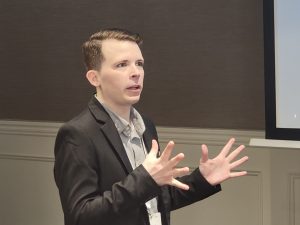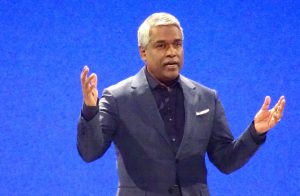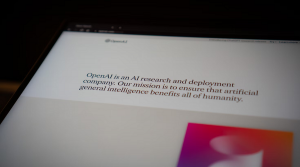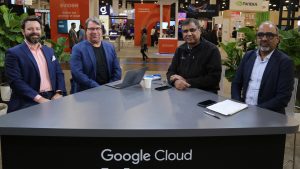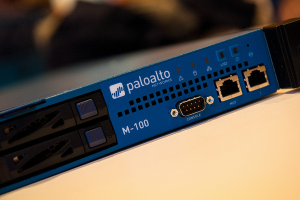IT’s “break and fix” mentality, and how VMTurbo is shifting it | #EMCWorld
![]() This week’s EMC World 2014 Event, held at The Sands Convention Center in Las Vegas, is theCUBE’s fifth year in attendance and also one of the two live broadcasts brought to you by SiliconANGLE. In this interview, Yuri Rabover, Founder of VMTurbo, joins John Furrier and Dave Vellante to discuss how his company works to change IT’s “break and fix” mentality.
This week’s EMC World 2014 Event, held at The Sands Convention Center in Las Vegas, is theCUBE’s fifth year in attendance and also one of the two live broadcasts brought to you by SiliconANGLE. In this interview, Yuri Rabover, Founder of VMTurbo, joins John Furrier and Dave Vellante to discuss how his company works to change IT’s “break and fix” mentality.
Furrier started off the interview by asking Rabover what he thinks of this year’s EMC World. He replied that he was impressed with the event and seemed pleased about the recognition of virtualization software definition. Rabover said that he believes that “the world is driving in the right direction.”
- VMTurbo
The topic of conversation then steered towards VMTurbo. Furrier asked Rabover to give an update on the company. He described that it started five years ago and that they received their first round of venture funding in December 2008, during the global financial crisis. Rabover shared that it was both “impressive and challenging” to get their first funding at a time when a bank a week went down. He also mentioned that VMTurbo started selling their first solution in Q1 of 2010 and has grown 320 percent since that time – a 100 percent growth rate year after year. The company currently has about 600 paying customers and over 10,000 free users.
The Virtualization Landscape
.
Furrier then talked about virtualization being a big part of the trend and Flash changing the game from a persistent storage standpoint. He asked Rabover what the DSSD acquisition now means to the EMC ecosystem. However, Rabover wasn’t able to offer a response as he had just gotten word of the news a few hours before the interview.
Moving on, Furrier started discussing stable infrastructure on the Flash array and how virtualized stuff is currently hot. Rabover agreed and also added that this, combined with other trends, creates an interesting environment. He considers Virtual Xen and SDN to be two key pieces of technology that are heavily important in the market. “They actually drastically changed the way the industry is going to work because, if V Xen catches up, it may have an impact on a parent company like EMC because of storage communitization.”
Vellante then entered the discussion talking about the return of server SAN and asked Rabover if he thinks it’s going to take off. Rabover responded that it will take off and also believes it’s natural that this is happening now. He added that it’s a tough time for hardware vendors and that “they need to react.”
Shifting IT’s “Break and Fix” Mentality
.
Circling the conversation back to VMTurbo, Vellante asked Rabover to talk about what problem the company is solving. He described that the company is trying to guarantee workload service levels, while, at the same time, increasing and maximizing infrastructure utilization efficiency. Rabover mentioned that this a really important problem that, though recognized, is not solved. He went to describe that IT is the only industry today that has a “break and fix” mentality, meaning it relies on human labor to fix problems as there’s an expectation for things to be broken.
Rabover brought up nuclear plants and airlines as examples of industries that have systems in place to prevent problems, rather than waiting for problems to happen. “No other mission critical industry in the world works like that,” said Rabover. This is the problem that VMTurbo is trying to solve.
Vellante then asked how VMTurbo solves this. Rabover responded saying, “Our solution, using the common data model, attaches all the layers of the IT stack – represent them as a single common data model and allows to, basically, bring the workload demand with the equilibrium of the infrastructure supply. If we accomplish this equilibrium using our economics scheduling engine, the workload will definitely receive the resources it needs. It means the service levels will be intact. But, because it’s an equilibrium, the infrastructure utilization will be as high as possible and safe for the workload levels.”
Further explaining the value of this solution, Rabover said, “You can always throw in a lot of hardware or you can increase the utilization of the infrastructure. However, if you need to accomplish – what we call the intelligent workload management problem – how do it at the same time, this is very challenging.” He also explained that this “supports pretty much everything which exists on the market,” including all hypervisors, cloud solutions and specific storage solutions like EMC.
Vellante then went on to ask Rabover how he’s able to support all this. He responded saying that they have a common data mortem and layered architecture that allows them to abstract everything into a single layer that doesn’t depend on the specifics of the infrastructure.
- Bringing Teams Together
After briefly discussing Viper and how the difference with VMTurbo is that they actively control all the storage technology, Vellante questioned Rabover about the friction between VM and storage admins and how he addresses this problem. Rabover said that this problem is rooted in the physical world, where these teams were separated. It was easier to manage because everything was static, nothing was shared and people could away with things. However, as today everything is shared, the divide is more obvious.
“Our solution actually helps these multiple teams – not only server and storage teams, but them in particular – to actually have the common discipline of control. We actually unify various disciplines under a single controlled plane and help bring these teams together.,” said Rabover. In fact, his customers have pointed out that one of their value points is team unification.
- Tech in 2014: “The Industry Needs Something New”
Concluding the interview, Furrier asked Rabover why 2014 is such an exciting and important time in the history of technology.
Rabover responded, “I think the industry reached the point where everything is defined in software and it needs badly different ways of managing it. I believe we’ve reached the critical mass of new technology components and new technology approaches, and it’s time to recognize that the old ways of managing this infrastructure, which has roots like 20, 30 years ago, can no longer be used. The industry needs something new.”
A message from John Furrier, co-founder of SiliconANGLE:
Your vote of support is important to us and it helps us keep the content FREE.
One click below supports our mission to provide free, deep, and relevant content.
Join our community on YouTube
Join the community that includes more than 15,000 #CubeAlumni experts, including Amazon.com CEO Andy Jassy, Dell Technologies founder and CEO Michael Dell, Intel CEO Pat Gelsinger, and many more luminaries and experts.
THANK YOU









